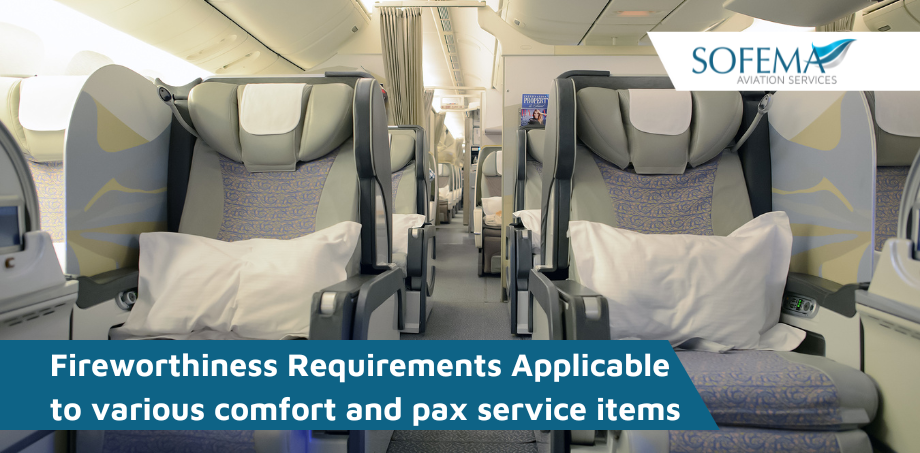Sofema Aviation Services (SAS) www.sassofia.com considers applicable regulations related to the Fireworthiness of Aircraft “carry on” of various comfort and pax service items including Galley Equipment & Blankets / Pillows.
Introduction – European Regulatory Requirements
Currently (May 2022) EASA does not proscribe any regulations related to Galley Inserts, Catering Products, and Blankets & Pillows – So where does this leave the airlines?
Essentially cabin items are exempt from undergoing a flammability test. Blankets, pillows, headrest protectors, and carry-on items are not part of the aircraft type design and are therefore not required to meet the flammability certification standard. However, this does not mean that the operator is absolved from any responsibility.
- Consider that the operator has a number of obligations outside of the airworthiness regulatory environment related to environmental, health, and safety as well as other areas related to due diligence duty of care.
- FAA States the following – Blankets, pillows, headrest covers, and carry-on items that are not part of the aircraft type design are not required to meet the flammability standards. (Amendment 25-32).
- EASA neither references such a requirement nor “non-requirement”.
- Note following a serious incident the FAA has such an “optional” procedure for performance of fire testing of Blankets within the FAA system – reference DOT/FAA/AR-96/15 – The Development of a Flammability Test Method for Aircraft Blankets.
What is Role-Specific Equipment?
Role equipment is additional equipment fitted to the aircraft to carry out a dedicated function and is usually not fitted by the aircraft manufacturer.
- Some examples of aircraft use requiring role equipment are:
o Search and Rescue,
o Medivac,
o Surveillance and
o Geographical Surveying.
- If the role equipment is attached to the aircraft in any way, be it mechanically or electrically, the equipment must be assessed against the requirements of the aircraft certification basis and other airworthiness requirements.
- If the role equipment is not part of the aircraft, it is again excluded from the regulatory requirements.
Galley Inserts – Fire Containment of Waste Stowage Compartments
- The Fire Containment Test of Waste Stowage Compartments is used by the aerospace/aviation industry to determine the fire containment capability of containers, carts, and compartments used to store combustible waste materials.
- Test Summary
o The receptacle is filled with combustible materials simulating common aircraft waste (e.g. cups, napkins, utensils, etc.).
o The combustible materials are ignited and the unit is closed.
o After the resulting fire dies out, the test is terminated and the unit is examined for damage. The receptacle must contain the fire and prevent flames from escaping.
o Test Sample Requirements – The unit to be tested is typically equivalent to the actual production unit.
o Maximum misalignment with regard to air gaps, seal interfaces, overlaps, etc. are simulated in the test unit.
o Stowed cart test arrangements require a galley structure equipped with power outlets and air inlet/outlet ducting to simulate in-flight use.
o If a liner is used within a waste compartment, the test must be conducted both with and without the liner installed.
- Products Requiring This Test:
o Containers, carts, and compartments used to store combustible waste materials in commuter or transport category aircraft and in transport category rotorcraft require the Fire Containment Test.
o These items typically include:
– Entree Carts
– Meal Carts
– Meal Boxes
– Waste Carts
– Waste Compartments
Considerations related to your organisation’s operations & due diligence
- How are you ensuring the “in service” serviceability of Galley Carts / Wheels & Brakes – When & How Assessed – Is this part of your Quality Assurance Audit Program?
- Galley Cart Trash Bin Sealing is assessed when and how (against what standard)?
- Regarding Blankets & Pillows etc. – what is your organizational criteria for assessment/testing – who is responsible – how are the requirement communicated with your 145 organisation – what certification is required (for example C of C against a company standard?)
- Regarding Blankets & Pillows etc cleaning & servicing – how is your wash/return to service procedure validated (consider the risk of pax complaint due to bed bugs – creatures found in the product and the potential reputational damage).
Next Steps
Follow this link to our Library to find & Download related documents for Free.
Sofema Aviation Services (SAS) provides Consultancy, Classroom, Webinar and Online Training including a 5-day EASA CS 25 Compliant Cabin Certification & Mods Training Program.
For additional details, please see our websites www.sassofia.com and www.sofemaonline.com or email team@sassofia.com
Tags:
Aircraft, aviation, Aviation Quality Assurance, Aviation Training, EASA, EASA compliant, EASA requirements, Aviation Industry, FAA, Air Carriers, CS 25, CS 25 Regulatory Training, Fireworthiness, European Regulatory Requirements




